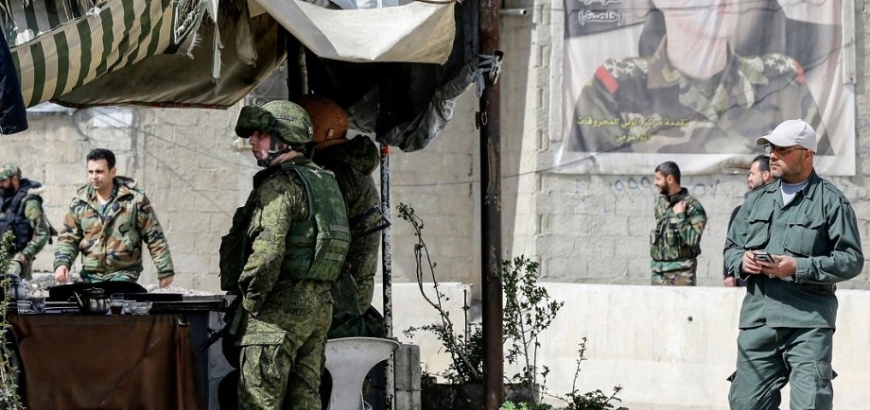In a surprise step, two Syrian areas have witnessed the withdrawal of Iranian militias, with Russian soldiers and military vehicles taking their places, amid silence from the two countries regarding these movements.
After the Bashar al-Assad regime and its allies took control over part of Deir ez-Zor, which is also controlled by the Syrian Democratic Forces (SDF), Iran bolstered its presence both militarily and religiously with the aim of spreading Shi’ism among the residents and winning some of their loyalty by offering enticements.
However a new development has impacted the Iranian presence in the eastern Syrian province, with the Furat Post Network, which monitors developments in eastern Syria, saying that Iranian militias backing the regime have withdrawn all their fighters from the city of al-Mayadin and the town of Mahkan toward Albu Kamal, saying that Russian forces have taken their place.
On Saturday, the Network said on its Facebook page that on Saturday, Russian reinforcements arrived at the city of al-Mayadin, while the pro-regime Al-Masdar News site said that the Russian forces, which arrived to Deir ez-Zor, included special forces and anti-missile vehicles.
This Russian deployment is the first of its kind west of the Euphrates at a time when the Islamic State (ISIS) is continuing to operate from a pocket in the Deir ez-Zor desert.
Before their withdrawal from these areas in Deir ez-Zor, Iranian militias left the T-4 airbase in the Homs countryside at the start of last week, which had been one of the most prominent concentrations of Iranian forces in Syria.
Iranian forces were replaced by Russian forces, and military sources said that Russia intended to deploy its S-300 missile batteries which were recently delivered to the Assad regime, after the latter accidentally downed a Russian IL-20 plane, for which Russia blamed Israel, saying that Israel had been carrying out strikes in Syria in the same area in which its planes were flying.
Iranian forces were subjected to Israeli bombardments during May 2018, and Israel approved the raid which was said to have killed seven Iranian soldiers.
New Plan?
In statements to Alsouria Net, the director of the information unit at the Omran Center for Strategic Studies, Nawar Oliver, said that Iran seems to be resorting to a new plan to protect itself in Syria, adding that it will not withdraw from any area in Syria until it has secured an alternative which serves its interests. He said that Iran depends on Syrian fighters in the militias, which receive direct support from Tehran.
Oliver pointed out that fighters from some militias backed by Iran had been integrated into formations under Assad’s forces or security branches. He said that fighters from the Imam al-Hussein militia in Deir ez-Zor joined the Fourth Division which is present there, while fighters from the Abou al-Fadel al-Abbas militia joined the Republican Guard.
Oliver believed that this Iranian withdrawal did not mean Tehran was losing its interests but that it had begun to increase its reliance on local proxy militias. This gives the appearance of Iran complying with international requests for its fighters, which are considered to be illegal, to withdraw.
In a report published on Oct. 4, 2018, Alsouria Net quoted sources in southern Syria as saying that Tehran was working to ensure long-term influence there by relying on proxy militias in the area which guarantee their interests without the need for Iranian fighters there.
Iran has attempted to avoid Israeli airstrikes on its forces in two ways. Alongside its reliance on local proxies to a large extent and placing its military bases near concentrations of Russian forces to the extent that it is able, as it did in with its Wadi Jehenem facility in the town of Banyas on the Syrian coast.
This article was translated and edited by The Syrian Observer. Responsibility for the information and views set out in this article lies entirely with the author.


